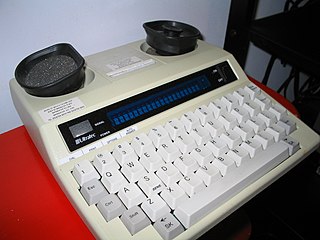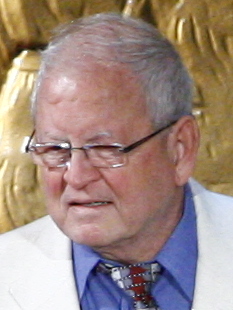
A telecommunications device for the deaf (TDD) is a teleprinter, an electronic device for text communication over a telephone line, that is designed for use by persons with hearing or speech difficulties. Other names for the device include teletypewriter (TTY), textphone, and minicom.

A telecommunications relay service, also known as TRS, relay service, or IP-relay, or Web-based relay service, is an operator service that allows people who are deaf, hard of hearing, deafblind, or have a speech disorder to place calls to standard telephone users via a keyboard or assistive device. Originally, relay services were designed to be connected through a TDD, teletypewriter (TTY) or other assistive telephone device. Services gradually have expanded to include almost any real-time text capable technology such as a personal computer, laptop, mobile phone, PDA, and many other devices. The first TTY was invented by deaf scientist Robert Weitbrecht in 1964. The first relay service was established in 1974 by Converse Communications of Connecticut.

Empresa de Telecomunicaciones de Cuba S.A. is the Cuban state company that provides telephony and communications services in Cuba. It is the sole lawful provider of telephony and telecommunications permitted by the Cuban penal code, constituting a communications state monopoly that has 8 million clients, both national and foreign.

106 Text Emergency Call, commonly known as simply 106, is the Australian national emergency telephone number to be used in life-threatening or time critical situations for those with a speech and / or hearing impairment who use telecommunications device for the deaf. It is run by the emergency telephone operator for the National Relay Service (NRS); formerly the Australian Communications Exchange (ACE), a non-profit organisation that provided the relay services component for the NRS. 106 can only be used by people with a TTY / textphone, or a computer with terminal software and a modem. 106 calls are given priority over other calls handled by the National Relay Service. 106 is a free-to-call number.

A video relay service (VRS), also sometimes known as a video interpreting service (VIS), is a video telecommunication service that allows deaf, hard-of-hearing, and speech-impaired (D-HOH-SI) individuals to communicate over video telephones and similar technologies with hearing people in real-time, via a sign language interpreter.
Text over IP is a means of providing a real-time text (RTT) service that operates over IP-based networks. It complements Voice over IP (VoIP) and Video over IP.
The Florida Public Service Commission (FPSC) regulates investor-owned electric, natural gas, and water and wastewater utilities. The FPSC facilitates competitive markets in the telecommunications industry, has authority over intercarrier disputes, and oversees pay telephones, the federal Lifeline Assistance Program and Telecommunications Relay Service.

Robert Haig Weitbrecht (1920-1983) was an engineer at SRI International and later the spin-off company Weitbrecht Communications who invented a type of a modem.
Next Generation 911 refers to an initiative aimed at updating the 911 service infrastructure in the United States and Canada to improve public emergency communications services in a growing wireless mobile society. In addition to calling 911 from a phone, it intends to enable the public to transmit text, images, video and data to the 911 center. The initiative also envisions additional types of emergency communications and data transfer. This NG911 infrastructure is intended to replace the current services over time. The National Emergency Number Association (NENA) first identified the need for NG911 in 2000, and started development actions in 2003, and is nearing full definition and standards for NG911. Since 2006, the US Department of Transportation (DOT) in the United States and the Canadian Radio-television and Telecommunications Commission (CRTC) in Canada have been leading their respective initiatives, which include research and development projects aimed at advancing NG911. On January 24, 2013, the CRTC announced the first step toward a Canadian implementation of NG911 and, in March 2016, began a consultation with the public to discuss what services should be offered, who will play a role in offering these services and how these services should be paid for. Several US states have implemented versions of NG911, as of October 2013.
Dr "Ed" Bosson is best known for his invention of the Video Relay Service which has provided the ability to connect between hearing and deaf communities through the means of video and sign language interpreters. Bosson then went on a long career as an administrator for the Texas Public Utilities Commission (PUC).
An organic minute is defined as the natural state of which telecommunications relay calls are processed between caller and called parties through Communications Assistant that are in conversation mode; that is, no incentives to encourage unnecessary relay minutes.
James Carlyle Marsters was a deaf orthodontist in Pasadena, California, who in 1964 helped invent the first teletypewriter device capable of being used with telephone lines. The device made communication by telephone possible for the deaf. Although Robert Weitbrecht did much of the actual design work, Marsters promoted the device's use.

Paul Taylor was an American engineer, a pioneer in development of telecommunications devices for the deaf. He also enjoyed a kind of celebrity status because of his central role in the award-winning documentary Hear and Now. The film by daughter Irene Taylor Brodsky chronicles the before and after experiences of her parents, Paul and Sally Taylor, both of whom underwent cochlear implant surgeries in their mid-60s after a lifetime of deafness.
Real-time text (RTT) is text transmitted instantly as it is typed or created. Recipients can immediately read the message while it is being written, without waiting.
Canadian Hearing Services was founded in 1940 to provide services for deaf and hard of hearing people in Ontario. Services include instruction in American and Quebec sign languages, interpreter services, deafblind intervenors, audiology and speech–language pathology. The CHS advocates for the hearing impaired in Canada through the support of 9-1-1 texting, visual fire alarms, and access to the justice system. The CHS handles emergency situations in hospitals, emergency rooms, after-hours clinics, shelters, and police services.
Assistive Technology for the Deaf and Hard of Hearing is technology built to assist those who are deaf or suffer from hearing loss. Examples of such technology include hearing aids, video relay services, tactile devices, alerting devices and technology for supporting communication.

Moshe Shem Tov was the chairman of the Central Committee of The Association of the Deaf in Israel (Acha) from 1972 to 1989. Shem Tov was the first chairman of the Acha, who approved the conducting of the leadership courses for young Deaf people without experience, and trained them in collaboration with the Ministry of Labor and Social Welfare in Israel and the Hanns Seidel Foundation, to be the next generation of the leaders in Acha.
Treatment depends on the specific cause if known as well as the extent, type, and configuration of the hearing loss. Most hearing loss results from age and noise, is progressive, and irreversible. There are currently no approved or recommended treatments to restore hearing; it is commonly managed through using hearing aids. A few specific types of hearing loss are amenable to surgical treatment. In other cases, treatment involves addressing underlying pathologies, but any hearing loss incurred may be permanent.

The Edmonton Association of the Deaf (E.A.D.) is an Albertan non-governmental organization that works to promote the interests of the Deaf community in Edmonton, Alberta, Canada.









